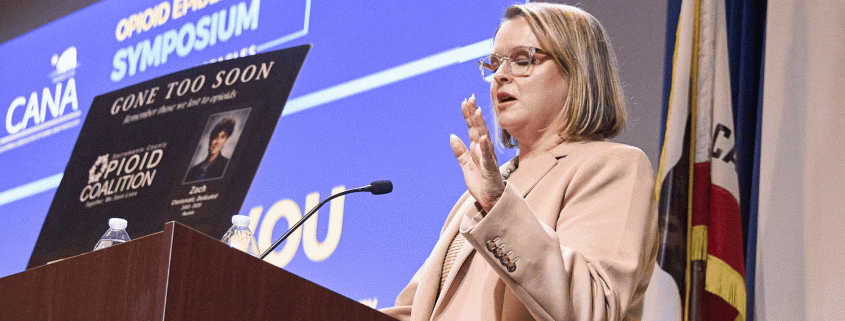California Association of Nurse Anesthesiology Hosts 2025 Opioid Epidemic Symposium: Identifying Obstacles, Inspiring Solutions
(Sacramento, CA) – Today, the California Association of Nurse Anesthesiology (CANA) brought together legislators, health care experts, policymakers, and community advocates to tackle one of California’s most pressing public health challenges. CANA’s 2025 Opioid Epidemic Symposium: Identifying Obstacles, Inspiring Solutions featured powerful testimonials, practical strategies, and innovative approaches to help address the crisis in California, including the role of Certified Registered Nurse Anesthesiologists (CRNAs) in providing opioid-free pain management techniques.
“Today’s Symposium demonstrated the critical importance of partnerships to reduce care gaps and advance meaningful recovery policies,” said Emily Francke, CRNA and President of CANA. “California CRNAs are at the forefront of compassionate, evidence-based pain management, working collaboratively with physicians, policymakers, and community leaders to ensure patients receive exceptional care. By working together, we can expand access to innovative solutions, protect those at risk of substance use disorder (SUD), and save lives across the state.”
The all-day event, held during National CRNA Week (January 19-25) at the Secretary of State’s Auditorium, included expert policy panels focused on effective strategies to combat the opioid crisis and areas in need of improvement, such as empowering youth to make informed decisions and prioritize their mental well-being.
“My 14-year-old son tragically died in 2020 after unknowingly ingesting a counterfeit, fentanyl-laced pill,” said Amy Neville, President of the Alexander Neville Foundation. “Alexander’s story is a heartbreaking reminder of the opioid crisis’ widespread reach and that we must do more to protect our youth. Prevention and education are critical tools in this fight.”
The event also emphasized how California CRNAs can help prevent SUD by providing safe and effective opioid-free pain management solutions. A 2018 Stanford University School of Medicine study published in JAMA Internal Medicine found an alarming link between opioid prescriptions for routine procedures, like wisdom teeth extractions, and SUD risk in teens and young adults. By offering opioid-free pain management, in addition to Medication Assisted Treatment (MAT), CRNAs have the ability to help reduce the risk of long-term opioid misuse for first-time users and provide evidence-based recovery techniques for those living with SUD.
“The opioid epidemic impacts every community in California,” said Assemblymember Heath Flora (R-Ripon), Vice Chair of the Business and Professions Committee. “By empowering health care providers, like CRNAs, to expand access to proven care techniques and ensuring collaboration among our local leaders, we can bridge resource gaps, implement effective strategies, and better protect our neighbors – particularly those in rural and underserved regions of the state.”
Through open dialogue and innovative thinking, the Symposium encouraged diverse perspectives on tackling the opioid crisis.
“Every day I see firsthand the devastating toll the opioid epidemic takes on our communities. To truly combat this epidemic and seek justice for victims, we need comprehensive tools, including enhanced prevention efforts, effective treatment programs, and strong partnerships that prioritize public safety and the wellbeing of those impacted,” said Nina Salarno, Modoc County District Attorney and Founder of Crime Victims United. “Together, we can forge a path to recovery and resilience for our families and neighborhoods.”
By working together to implement sustainable, evidence-based solutions, California policymakers, health care providers, and community leaders can better address the immediate challenges of opioid misuse while promoting long-term recovery and prevention strategies.
“We cannot overstate the importance of meeting people where they are and providing the help they need when they need it – whether it’s treatment, recovery support, or lifesaving interventions,” said Shasta County Sheriff Mike Johnson. “This means balancing compassion with responsibility to ensure we’re offering the support needed to break the cycle of addiction while maintaining public safety.



